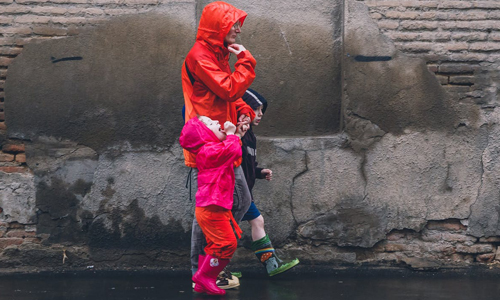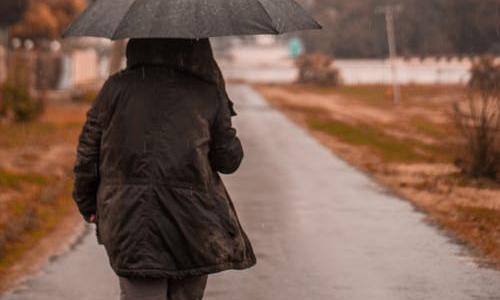Picking the Right Rain Jacket Is Not as Difficult as You Think – Here’s Why
Author

Chris shares his passion for cycling, hiking, skiing, and climbing from Buxton, in the Peak District. As a blogger for Outdoor Look, Chris shares outdoor tips and indoor tricks to help you get the most out of your time spent outside. When he's not out adventuring he's making videos or trying to keep up with his 4-year-old son.
No matter you are an outdoor adventurer or not, whenever it rains, the first thing you look for is a raincoat or rain jacket that can keep you dry. Isn’t it? Now, discussing from the perspective of a traveller or hiker, a rain jacket is one of the most important equipment for them as it provides safety and comfort during their journey, thus, has to be a quality product. With an overflow of brands and options present on the market, choosing the right one might become an overwhelming task. But if you know the basic specifications to be considered during the buying process, you can grab the best rain jacket in no time.
Check out the factors you need to keep in mind before you start scratching your head seeing all those amazing options lying in the store.
For those who want a quick sneak-peak into what are the main pointers of the selection process, take a cursory look here.
- Waterproof or Water-Resistant: Decide whether you want a rain jacket for occasional light precipitation or heavy rainfall?
- Type of Rain Jacket Layer: See, what kind of rain jacket layer is the best one for you, is it 2-layer, 2.5-layer, or 3-layer?
- Additional Features: Check what extra features you want in your jackets such as hoods, pockets, or any other according to your outdoor activity.

Waterproof v/s Water-Resistant
Water-Resistant: A water-resistant rain jacket is available with coating of the durable water repellent (DWR) finish that can protect you from occasional light rain. Made from materials like polyester and nylon, the jackets have been treated with the water-resistant treatment and are not completely waterproof, thus are not effective under heavy downpours.
Waterproof: Having a waterproof jacket means water cannot enter inside and it can easily withstand continuous and heavy rainfall and keep you dry. GORE-TEX, DryQ, and Hyvent are some of the common waterproof membranes used for waterproof jackets.
All in all, no matter if it is a water-resistant or waterproof jacket, DWR finish is usually used as a spray on both the types. It is used as a coating on the outer layer rather than permeating, doing this will let water roll off the jacket.
The Kind of Layer
The next thing you need to consider is - for what purpose you need a rain jacket and then accordingly decide the layer you want. There are 3 different types of layers available, check out the individual features of these layers.
2- Layer Rain Jacket: A rain jacket with 2-layers, which is considered when you want to roam around the town and in case of light precipitation. These jackets usually don’t come with armpit ventilation, thus are not considered for the high-intensity activities.
2.5-Layer Rain Jacket: If you want to leave for the high-intensity outdoor activities, a rain jacket with 2.5 layers is a great option to be considered. These jackets are available with arm-pit zips for proper ventilation. The jacket is quite lightweight and easy to pack as compared to the 3-layer jacket. If you’re a travel enthusiast, a rain jacket with a 2.5 layer is the best option to start with.
3-Layer Rain Jacket: Next on the list is a rain jacket with 3-layers, which is quite technical and you need to pay a higher amount as compared to the jackets mentioned above. These jackets are heavy, tough, and can withstand any type of weather condition. GORE-TEX membrane is majorly used on these jackets. If you’re going on a trek, hike, or travelling otherwise that includes spending time in nature, a 3-layer rain jacket is an ideal option.

Additional Features
Apart from these prime features, there are a few additional qualities you can look for in your rain jacket, which includes:
Perfect Hood Size: You don’t want to constantly adjust the hood of your rain jacket while travelling, so find the jacket with a hood that fits perfectly like a helmet and secure your head from rain.
Pockets: If you’re planning for backpacking, a rain jacket with pockets would be a great choice. A chest pocket is ideal for keeping small items handy like your map. If you want a jacket to wear within the city, an option with fewer pockets could be a nice pick.
You see how easy it was to get into the selection process. Remember that the rain jacket is more than its look. Technical features and other functions should be kept in mind carefully for ease of wearing and comfort. You’re investing in an essential, thus, ensure you’re doing it the right way.
Author

Chris shares his passion for cycling, hiking, skiing, and climbing from Buxton, in the Peak District. As a blogger for Outdoor Look, Chris shares outdoor tips and indoor tricks to help you get the most out of your time spent outside. When he's not out adventuring he's making videos or trying to keep up with his 4-year-old son.
- Speed Up Your Post-Hike Recovery with These 6 Essential Tips
- Cycling through Tranquil Roads and Coastal Views on the Isle of Wight
- The Essential Guide to Hiking Safety: 5 Tips Every Hiker Should Know
- Run Smart, Run Strong: Your Guide to Injury-Free Running
- Embrace Biking: Essential Tips for Beginners
Categories
- Sport (28)
- Product Reviews (3)
- Team Outdoor Look (7)
- Mike Wild (2)
- Mike Payton (2)
- Suse Hammond-Pears (3)
- Snowboarding (12)
- Latest Offers (105)
- Shop Talk (1)
- Competitions (7)
- Walking (413)
- Lifestyle Fashion (8)
- Travel (86)
- Kit Guides (176)
- Workwear Clothing (6)
- Safety Workwear (4)
- Health/Fitness (289)
- Skiing (91)
- Great Outdoors (1316)
- Cycling (92)
- January 2025
- December 2024
- November 2024
- October 2024
- September 2024
- August 2024
- July 2024
- June 2024
- May 2024
- April 2024
- March 2024
- February 2024
- January 2024
- December 2023
- November 2023
- October 2023
- September 2023
- August 2023
- July 2023
- June 2023
- May 2023
- April 2023
- March 2023
- February 2023
- January 2023
- December 2022
- November 2022
- October 2022
- September 2022
- August 2022
- July 2022
- June 2022
- May 2022
- April 2022
- March 2022
- February 2022
- January 2022
- December 2021
- November 2021
- October 2021
- September 2021
- August 2021
- July 2021
- June 2021
- May 2021
- April 2021
- March 2021
- February 2021
- January 2021
- December 2020
- November 2020
- October 2020
- September 2020
- August 2020
- July 2020
- June 2020
- May 2020
- April 2020
- March 2020
- February 2020
- January 2020
- December 2019
- November 2019
- October 2019
- September 2019
- August 2019
- July 2019
- June 2019
- May 2019
- April 2019
- March 2019
- February 2019
- January 2019
- December 2018
- November 2018
- October 2018
- September 2018
- August 2018
- July 2018
- June 2018
- May 2018
- April 2018
- March 2018
- February 2018
- January 2018
- December 2017
- November 2017
- October 2017
- September 2017
- August 2017
- July 2017
- June 2017
- May 2017
- April 2017
- March 2017
- February 2017
- January 2017
- December 2016
- November 2016
- October 2016
- September 2016
- August 2016
- July 2016
- June 2016
- May 2016
- April 2016
- March 2016
- February 2016
- January 2016
- December 2015
- November 2015
- October 2015
- September 2015
- August 2015
- July 2015
- June 2015
- May 2015
- April 2015
- March 2015
- February 2015
- January 2015
- December 2014
- November 2014
- October 2014
- September 2014
- August 2014
- July 2014
- June 2014
- May 2014
- April 2014
- March 2014
- February 2014
- January 2014
- December 2013
- November 2013
- October 2013
- September 2013
- August 2013
- July 2013
- June 2013
- May 2013
- April 2013
- March 2013
- February 2013
- January 2013
- December 2012
- November 2012
- October 2012
- September 2012
- August 2012
- July 2012
- June 2012
- May 2012
- April 2012
- March 2012
- February 2012
- January 2012
- December 2011
- November 2011
- October 2011
- September 2011
- August 2011
- May 2010
- April 2010
- March 2010
- February 2010
- January 2010
- November 2009
- October 2009
- September 2009
Submit a Comment